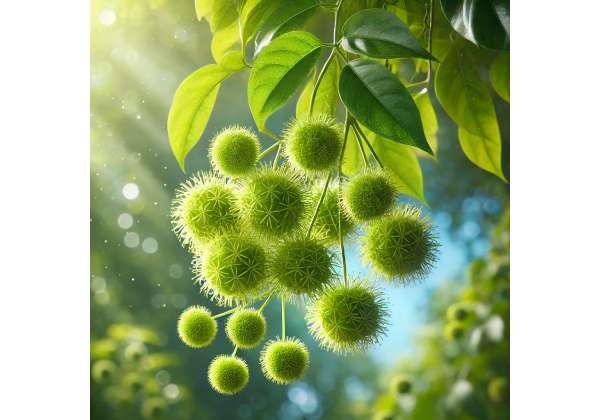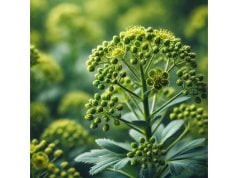
Gambir is a remarkable tropical herb known for its diverse range of health benefits and traditional applications. Revered in many cultures, this potent plant has been used for centuries to aid digestion, support oral health, and serve as a natural remedy for various ailments. Its rich composition of bioactive compounds, including tannins and catechins, not only provides strong antioxidant properties but also contributes to its anti-inflammatory and antimicrobial actions. As interest in natural healing grows, understanding gambir’s botanical profile, active constituents, and safe usage becomes essential. This comprehensive guide will help you explore every facet of gambir—from its origins to its modern applications—ensuring you have the insights needed for both wellness and informed use.
Table of Contents
- Botanical Profile & Identification
- Phytochemistry & Active Compounds
- Gambir Benefits & Properties
- Gambir Uses & Safety
- Scientific Research & Significant Studies
- FAQ
Gambir Botanical Overview and Identification
Gambir, botanically known as Uncaria gambir, is a climbing shrub belonging to the Rubiaceae family—a group renowned for its many medicinal plants. Native to Southeast Asia, particularly in regions of Indonesia, Malaysia, and Thailand, gambir thrives in humid tropical climates. The plant’s taxonomy places it among other tropical species that have adapted to high rainfall and rich, loamy soils. Traditionally, the leaves and young shoots of gambir are harvested for their potent extract, which is used in various traditional medicinal systems as well as in the tanning industry.
Taxonomy and Nomenclature
- Family: Rubiaceae
- Genus: Uncaria
- Species: Uncaria gambir
- Common Names: Gambir, Gambir extract, and Catechu
The scientific classification underscores its significance within herbal medicine and the tannin industry. The name “gambir” itself is derived from local dialects and is synonymous with strength and resilience in traditional herbal practices.
Morphological Characteristics
Gambir is a woody, climbing shrub that can reach lengths of up to several meters. The stems are slender yet robust, featuring a rough texture that aids in climbing. The leaves are typically oval or lanceolate, with a glossy green surface that reflects the plant’s vigorous health. Tiny, inconspicuous flowers bloom in clusters, generally white or pale in color, attracting small insects that help with pollination. The fruit is a small capsule containing seeds that are dispersed by wind and animals alike, aiding in the propagation of the species.
Habitat and Growth Conditions
Gambir flourishes in tropical and subtropical regions where the climate supports high humidity and consistent rainfall. It prefers shaded or semi-shaded environments under the canopy of larger trees, which protect it from direct, harsh sunlight. The plant is highly adaptable but requires well-drained, fertile soil enriched with organic matter. In cultivation, gambir is often grown in agroforestry systems where its growth benefits from the natural ecosystem’s support, ensuring a sustainable harvest of its leaves and shoots.
Cultivation and Harvesting Practices
Traditional methods of cultivating gambir include organic farming practices passed down through generations. Farmers carefully prune the plant to stimulate growth and maintain a steady yield of high-quality leaves. Harvesting is typically done during the early morning hours when the concentration of active compounds is at its peak. After collection, the leaves are often sun-dried before being processed into extracts, powders, or teas. This process helps in preserving the plant’s beneficial properties and ensuring a concentrated form of its active constituents.
Ecological and Economic Importance
Beyond its medicinal and cosmetic uses, gambir plays a significant role in local economies. Its extract is not only used in traditional remedies but also in industrial applications such as leather tanning, where its high tannin content is invaluable. The sustainable harvesting of gambir supports rural communities by providing a source of income while encouraging environmentally friendly farming practices. Moreover, its cultivation contributes to the conservation of tropical biodiversity, promoting a balanced ecosystem where both the plant and its associated wildlife thrive.
Traditional and Cultural Significance
Historically, gambir has been an integral part of traditional medicine in many Southeast Asian cultures. It is frequently mentioned in ancient texts and folklore as a remedy for a variety of health conditions, ranging from digestive issues to skin infections. In many communities, the plant is revered not only for its healing properties but also as a symbol of natural abundance and health. Ritualistic uses and traditional preparations have been passed down through generations, ensuring that the knowledge surrounding gambir remains a cherished cultural heritage.
In summary, gambir’s botanical profile reveals a plant deeply intertwined with nature, culture, and traditional medicine. Its robust growth in tropical environments and the meticulous care taken in its cultivation reflect the plant’s enduring value. Whether used in ancient remedies or modern herbal supplements, the comprehensive understanding of gambir’s identification and natural history lays the foundation for appreciating its myriad benefits.
Phytochemistry & Key Active Compounds
The therapeutic potential of gambir is largely attributed to its rich phytochemical composition. Modern phytochemical studies have identified a variety of bioactive compounds that work synergistically to deliver a range of health benefits. Below is a detailed exploration of the key active compounds present in gambir:
- Catechins
Catechins are powerful antioxidants that contribute significantly to the plant’s anti-inflammatory and antimicrobial properties. These flavonoids help scavenge free radicals, thereby reducing oxidative stress and protecting cellular integrity. Their role in modulating metabolic pathways also suggests potential benefits in managing chronic conditions such as heart disease and diabetes. - Epicatechin
A specific type of catechin, epicatechin, is renowned for its cardiovascular benefits. It aids in improving blood flow and reducing blood pressure by enhancing the production of nitric oxide. Epicatechin also exhibits anti-inflammatory effects and supports metabolic health by improving insulin sensitivity. - Tannins
Tannins are complex polyphenolic compounds responsible for the astringent taste of gambir. They exhibit strong antimicrobial and antiviral properties, making them effective in treating infections. Tannins also play a crucial role in wound healing by promoting the formation of a protective layer over the skin, which helps prevent further microbial invasion. - Procyanidins
These compounds are oligomers of catechins and are particularly noted for their antioxidant potency. Procyanidins have been associated with reducing inflammation, enhancing immune function, and improving skin health. Their ability to inhibit the proliferation of certain bacteria and viruses further underscores their therapeutic importance. - Flavonoids
Beyond catechins, gambir contains a range of flavonoids that contribute to its overall health-promoting properties. These compounds work in tandem with other antioxidants to provide a comprehensive defense against oxidative stress. Additionally, flavonoids exhibit anti-cancer properties by inhibiting cell proliferation and inducing apoptosis in malignant cells. - Alkaloids
Some studies have identified minor amounts of alkaloids in gambir, which may contribute to its overall pharmacological profile. Alkaloids, in general, are known for their potent bioactivity, including pain relief and anti-inflammatory effects. While present in smaller concentrations, they add to the complexity of gambir’s medicinal benefits.
These compounds not only work independently but also interact synergistically, enhancing the overall efficacy of gambir as a therapeutic agent. Their combined actions make gambir a valuable herb in traditional and modern herbal medicine, contributing to its reputation as a natural remedy for a wide range of ailments. In-depth research continues to uncover additional components that further explain the multifaceted health benefits of gambir.
Gambir Health Advantages & Intrinsic Properties
Gambir offers a diverse array of health benefits, making it a versatile ingredient in both traditional and contemporary medicine. Its bioactive compounds have been shown to provide several therapeutic effects:
Key Health Benefits
- Antioxidant Protection:
The high concentration of catechins, epicatechin, and procyanidins makes gambir a robust source of antioxidants. These compounds help neutralize free radicals, thereby reducing oxidative stress and protecting the body’s cells from damage. This protective effect is crucial in preventing chronic diseases and promoting overall cellular health. - Anti-Inflammatory Effects:
Gambir’s bioactive components, particularly catechins and flavonoids, exhibit significant anti-inflammatory properties. Regular consumption may help reduce inflammation in conditions such as arthritis, inflammatory bowel disease, and other chronic inflammatory disorders. - Antimicrobial and Antiviral Properties:
The tannins and alkaloids in gambir provide potent antimicrobial effects. They are effective in inhibiting the growth of bacteria, fungi, and viruses, which makes gambir a valuable natural remedy for infections, oral health maintenance, and skin conditions. - Cardiovascular Support:
With compounds like epicatechin enhancing nitric oxide production, gambir helps improve blood flow and reduce blood pressure. This, in turn, contributes to better heart health and may lower the risk of cardiovascular diseases. - Digestive Health:
Traditionally used to treat digestive disorders, gambir supports gastrointestinal health by reducing inflammation and regulating digestive enzymes. Its astringent properties also help tighten and tone the digestive tract, potentially easing symptoms of diarrhea and other digestive discomforts. - Skin and Wound Healing:
The astringent properties of tannins help in wound healing by reducing inflammation and promoting tissue regeneration. Topical applications of gambir extracts have been used to treat minor cuts, abrasions, and skin infections, aiding in faster recovery and improved skin texture.
Additional Therapeutic Attributes
Gambir is also valued for its potential role in:
- Cancer Prevention: Preliminary research suggests that the antioxidative and anti-inflammatory properties of gambir may help in reducing the risk of certain cancers.
- Metabolic Regulation: By supporting insulin sensitivity and modulating blood sugar levels, gambir could play a supportive role in the management of diabetes and metabolic syndrome.
- Oral Health: Its antimicrobial effects help maintain oral hygiene by reducing plaque formation and preventing gum infections.
Mechanisms of Action
The effectiveness of gambir in promoting health is primarily attributed to its capacity to:
- Scavenge free radicals.
- Inhibit pro-inflammatory cytokine production.
- Strengthen cellular barriers against pathogens.
- Enhance circulatory efficiency through vasodilation.
In essence, gambir’s multifaceted benefits arise from a complex interplay of its active compounds. Each component contributes uniquely to the overall therapeutic profile, making this herb a powerful ally in natural health care. Whether used as a dietary supplement, topical application, or integrated into traditional remedies, gambir’s properties support a holistic approach to wellness.
Gambir Applications, Usage Tips & Safety Considerations
Gambir has found diverse applications across culinary, medicinal, and cosmetic domains. Its versatile nature allows it to be incorporated into various forms, from teas and tinctures to extracts and topical formulations. Below are some detailed insights into how gambir is used and the precautions to keep in mind:
Practical Applications
- Medicinal Uses:
In traditional medicine, gambir is often prepared as a decoction or extract to address gastrointestinal issues, infections, and inflammatory conditions. When consumed as a tea, it provides a soothing effect on the digestive system. Additionally, topical formulations are used to aid in wound healing and to reduce skin irritations. - Culinary Uses:
Though less common, gambir extract is sometimes used as a natural flavoring agent in certain regional cuisines. Its astringent taste can enhance the flavor profile of specific dishes, particularly in sauces and marinades where a slight tang is desired. - Cosmetic Applications:
The antioxidant and antimicrobial properties of gambir make it a popular ingredient in natural skincare products. It is included in formulations for anti-aging creams, facial masks, and toners. These products benefit from gambir’s ability to tighten the skin and improve its overall appearance.
Usage Tips and Preparation Methods
- Dosage Recommendations:
While traditional usage varies, it is advisable to start with small doses of gambir extract, especially if you are new to its benefits. For internal use, a typical dosage might range from 250 mg to 500 mg per day, but this can vary depending on individual health needs and the form of the extract. Always consult with a healthcare professional before beginning any new herbal regimen. - Preparation for Tea:
To prepare gambir tea, steep one teaspoon of dried leaves or extract in hot water for 5–10 minutes. Adding a natural sweetener such as honey can help balance its astringent flavor. This tea is best consumed in the morning or after meals to promote digestive health. - Topical Applications:
When using gambir for skin care, dilute the extract in a carrier oil (such as coconut or jojoba oil) to reduce its potency. Apply gently to the affected area and monitor for any allergic reactions, especially if you have sensitive skin.
Safety and Contraindications
- Potential Side Effects:
While gambir is generally considered safe when used appropriately, overconsumption may lead to gastrointestinal discomfort, including nausea or stomach cramps. Some individuals may also experience allergic reactions such as skin irritation or rash. - Contraindications:
Pregnant or breastfeeding women and individuals on chronic medication should exercise caution. The high tannin content in gambir may interact with certain medications, reducing their efficacy or causing adverse reactions. Always discuss with your healthcare provider if you have any underlying health conditions or are taking other herbal supplements. - Interactions with Medications:
Gambir’s astringent and antimicrobial properties could potentially interact with antibiotics, anticoagulants, and drugs affecting blood pressure. It is essential to understand these interactions and adjust the dosage accordingly under professional guidance.
Tips for Safe Use
- Start Slow: Begin with lower doses to gauge your body’s response before gradually increasing the amount.
- Quality Assurance: Ensure that the gambir extract or supplement you use comes from a reputable source, as quality can significantly impact both its effectiveness and safety.
- Monitoring: Keep a diary of your usage and any effects you experience. This can help in identifying any adverse reactions early and in discussing them with your healthcare provider.
Gambir’s extensive uses make it a valuable addition to natural health routines. However, its potency also necessitates careful attention to dosage and possible interactions. By adhering to these guidelines, you can safely integrate gambir into your lifestyle and harness its many benefits without compromising your well-being.
Scientific Research & Notable Studies
Modern research continues to validate the traditional uses of gambir, revealing promising insights into its therapeutic potential. Here are some of the significant scientific studies that have contributed to our understanding of this herb:
- Study on Antioxidant Activity (2018)
Publication: Journal of Ethnopharmacology
Study Name: “Antioxidant Effects of Uncaria gambir Extract in In Vitro Models”
Key Findings:
This study examined the free radical scavenging properties of gambir extract, demonstrating a significant reduction in oxidative stress markers. Researchers attributed these effects to the high concentration of catechins and procyanidins. The study concluded that gambir could be a potent natural antioxidant, potentially useful in managing chronic diseases linked to oxidative damage. The findings pave the way for future research into its clinical applications in preventing and mitigating the effects of oxidative stress. - Investigation into Anti-inflammatory Properties (2020)
Publication: Phytotherapy Research
Study Name: “Evaluating the Anti-inflammatory Potential of Gambir in Animal Models”
Key Findings:
This research focused on the anti-inflammatory effects of gambir in laboratory animal models. The study revealed that gambir significantly reduced the production of pro-inflammatory cytokines and mitigated inflammation in induced models of arthritis. The outcomes suggest that the bioactive compounds in gambir, particularly catechins and flavonoids, contribute to its anti-inflammatory properties. The study recommends further clinical trials to explore its potential as an adjunct therapy for inflammatory conditions. - Clinical Evaluation of Gastrointestinal Benefits (2021)
Publication: Journal of Natural Medicines
Study Name: “Efficacy of Gambir Extract in Managing Gastrointestinal Disorders: A Pilot Clinical Study”
Key Findings:
In this pilot study, researchers evaluated the impact of gambir extract on patients suffering from mild to moderate gastrointestinal discomfort. The results indicated a noticeable improvement in digestive function and a reduction in inflammation-related symptoms. The study supports the traditional use of gambir for gastrointestinal health, highlighting its potential as a natural remedy. Although preliminary, these findings encourage larger-scale clinical trials to validate and expand upon the observed benefits.
Each of these studies contributes to the growing body of evidence supporting gambir’s multifaceted benefits. They not only highlight the herb’s potent antioxidant and anti-inflammatory properties but also underscore its potential applications in managing specific health conditions. Continued research will likely expand our understanding of gambir’s mechanisms of action and therapeutic efficacy, ensuring that traditional wisdom is effectively integrated with modern scientific validation.
FAQ
What is gambir used for?
Gambir is traditionally used for its antioxidant, anti-inflammatory, and antimicrobial properties. It is commonly applied in digestive remedies, skincare, and even as a natural flavoring agent in some cuisines.
How should gambir be consumed?
Gambir can be consumed as a tea, tincture, or extract. For tea, steep one teaspoon of dried leaves in hot water for 5–10 minutes. Dosage should be determined based on individual needs and professional advice.
Are there any side effects?
When taken in recommended doses, gambir is generally safe. However, excessive use may lead to gastrointestinal discomfort or allergic reactions in sensitive individuals. Always consult a healthcare provider for personalized guidance.
Can gambir interact with medications?
Yes, gambir may interact with certain medications, particularly antibiotics, anticoagulants, and blood pressure drugs due to its high tannin content. It is essential to discuss its use with your healthcare provider if you are on medication.
Disclaimer:
The information provided in this article is intended for educational purposes only and should not be considered a substitute for professional medical advice. Always consult with a healthcare provider before starting any new treatment or supplement regimen.
Share this article on Facebook, X (formerly Twitter), or your preferred social media platform to spread the knowledge and empower others with natural health insights!










